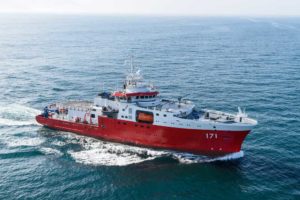Spanish shipyard Freire has delivered the DNV GL-classed »B.A.P. Carrasco« for Peru – one of the world’s most advanced polar oceanographic research vessels.
According to the Norwegian-German classification society, the vessel is packed with state-of-the-art technology, including [ds_preview]a meteorological office, six laboratories for different research purposes, a helicopter pad and a bathymetry transducer system fitted on the flat bottom of the hull. »This delivery is a testament to the skill of our great team at Freire and the excellent cooperation we have enjoyed with all of our project partners, but especially the Peruvian Navy and DNV GL,« says Guillermo Freire, Director General at Freire Shipyard.
»B.A.P. Carrasco« will be operated by the Peruvian Navy. »Her operating profile will range from hydrographic, biological, geological as well as physiochemical surveys to providing support with humanitarian operations,« says Walter Flores Servat, Head of the Department for Special Projects and Antarctic Matters at the Peruvian Navy. The Navy will also venture into Antarctic waters over the summer months, so the ship is built to withstand temperatures of minus 25 °C and can operate in up to one metre of ice coverage.2

Christian von Oldershausen, Segment Director Navy at DNV GL added that the newbuilding represents the »highest standards« in research vessels. According to Freire’s production manager Santos, the yard’s biggest challenge was to integrate all the ship’s systems and equipment into a very limited space. The bathymetry transducer system fitted on the flat bottom of the hull generates an array of acoustic beams with up to 10,000 metres of reach below the vessel to map the sea floor and feeds the data back to the vessel in realtime. The vessel will also carry a Falcon DR remotely operated vehicle (ROV), which can reach depths of up to 1,000 m, and two smaller, torpedo-shaped submarine vehicles by AUV Kongsberg.
»B.A.P. Carrasco« holds the DNV GL AP-3 notation. AP stands for alternative propulsion, and the notation covers the eventuality of any single failure of the propulsion systems. To meet this standard, the vessel needs two separate engine rooms and two propulsion rooms, which have to be watertight and insulated against fire. The piping systems for the propulsion can only be connected through valves in both sides of the bulkhead.
»This notation was very important to us because B.A.P. Carrasco will be venturing into restricted areas for very long periods of time, so we need to take all possible safety precautions. Certification to the AP-3 notation demonstrates that the propulsion system can continue operating at 50 per cent capacity in case of engine failure, ensuring a safe return to port,« explains Servat. The vessel will also be certified to the DNV GL CLEAN notation, which covers emissions to air from energy producers, cargo-handling systems and service systems on board, and DNV GL BWM-T, which prepares it for compliance with the Ballast Water Management Convention.
»The vessel will have a Hyde Guardian ballast water treatment system using UV-light technology. In addition, a selective catalytic reduction system, which treats nitrogen oxide (NOX) emissions with urea, ensures exhaust gases are reduced safely below particular emission limits,« says Santos. The Silent-A notation makes sure survey readings are not distorted by noise and vibrations from on-board systems. Heading back up from the engine rooms to the main deck.


















